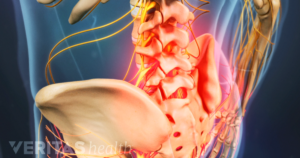
Spinal stenosis is an abnormal narrowing of the spinal canal that results in pressure on the spinal cord or nerve roots. Spinal stenosis occurs most often in the lower back and the neck.
Some people with spinal stenosis may not have symptoms; while others may experience pain, tingling, numbness or muscle weakness. Symptoms can worsen over time.
Can spinal stenosis cause hip pain?
Studies show that 94% of those who suffer from spinal stenosis will have discomfort while standing, including pain in the hip, buttock or thigh. Pain in the back is often accompanied by hip pain, but it’s important for a doctor to examine you, so as to make sure that spinal stenosis is cause of your hip pain, and rule out any other degenerative conditions.
Many times, those who begin to experience numbness or pain in their lower limbs from spinal stenosis will also have trouble with their gait. That can trigger hip pain as well.
In assessing lower back and hip pain physicians may sometime neglect to explore the possibility of a sacroiliac joint problem. Because of the complex anatomy of the area, it’s important to see an experienced specialist, who can identify the root cause of your hip and lower back pain.
A patient with arthritis in the hips may experience hip as well as trouble walking; while a patient with lumbar spinal stenosis may have pain down their leg, or neurologic symptoms such as numbness, tingling or weakness. A telltale sign that an issue with the hip is in play would be when the pain is accompanied by pain in the groin.
If your pain is alleviated by leaning forward or lying down, chances are pretty good that spinal stenosis could be involved.
Chronic pain is debilitating. Depending on its cause, stenosis can be progressive, getting worse with time.
Because hard-evidence that surgical interventions are effective remains scarce, strengthening spinal extensor muscles is often a better treatment option. This takes pressure off the disc because stronger muscles can handle more of the body weight that discs otherwise absorb.
The following exercises, recommended by University of California San Diego, can help alleviate some hip and back pain.
Some forms of spinal stenosis are caused by inflammation of the body’s joints — a condition known as spondylitis — which often includes inflammation and pain in the hip region.
Tests, such as a CT scan or MRI can identify narrowing of the lumbar or spinal canal, and identify where a nerve may be compressed.
While every effort has been made to provide helpful and factual information in this article, a visit to this site is not an acceptable substitute for a professional medical consultation. If you’re concerned about the cause of back or hip pain, contact your physician and ask them for guidance.

I am an 80 year old female diagnosed with spinal stenosis in 2023 I am awaiting surgery as I also have deteriorated disc plus a lumbar bone spur. That presses on my sciatic nerve & immobilizes me w intense pain. I have high BP & a stable 4.7 cm aortic aneurysm & take Atenolol & Clonidine. Since taking Clonidine, , my Buttocks & back of thighs near buttocks are so painful I can’t walk ; only laying gives relief. I thought it was from Clonidine but sine reading your article, I think it is caused by stenosis. What should I do.? I’m desperate to get my laugh back.
Hi Elaine
You have a very complex situation you’re dealing with. Definitely consult with your doctor on to get the support you need.
Regards
Bill